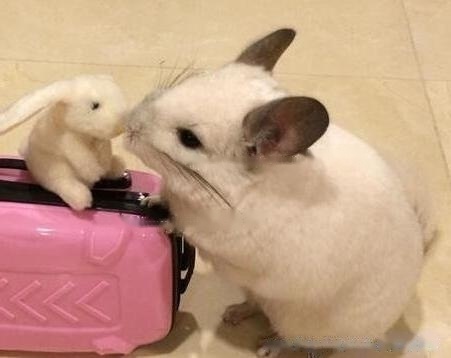pets friends will encounter the problem of some small animals getting sick more or less, and it is normal to have a small illness occasionally. Chinchillas The most common problem should be gastrointestinal problems, because chinchillas are vegetarian animals. Generally, the root cause of chinchillas sickness should be to pay attention to food and environment. Before chinchillas get sick, they should How to judge that it is sick? Today, the editor will tell you how to judge before the chinchilla is sick.

How can I tell if my chinchilla is sick?
1. The eyes are bright and clean
The chinchilla's eyes are very bright, Generally speaking, the eyes are all black or all ruby, and the eyes can immediately reflect the symptoms of chinchillas. The eyes should be crisp, bright, and clean, and the hair around the eyes should not be tangled or wet. 2. The ears are clean and the color is normal:
2. There should be no wax in the ears of chinchillas
, chinchillas will not scratch their ears frequently. Bright red ears indicate that the chinchilla is too hot, or has a fever from an illness.
3. Dry anus
Chinchilla's anus should be dry and clean. If you notice the anus is wet or the coat around it is wet, it may be having a diarrhea.
4. The stool is round and slightly moist.
The stool of the chinchilla should be plump and round, oval or round. The surface of the newly discharged poop should be smooth and slightly damp, but not muddy. When the poo is broken apart, it should be completely solid inside. If there is a cavity, it means there is a problem with the teeth or digestive system. If it is wet and dripping out, it is diarrhea. Small, hard stools indicate constipation or other more serious conditions.
5. The fur is smooth and uniform, and the color is shiny
The chinchilla's hair should be smooth and shiny, not tangled, and dry. If you see a patch of hair on your chinchilla that is noticeably shorter than other parts, your chinchilla may be having a biting problem, which means they are unhappy, stressed, or sick. A dull coat color indicates a health problem, especially if the hair on the thighs is a problem with the chinchilla's teeth, which requires special urgent attention. If the hair on the body is obviously uneven, you can gently blow the uneven part. If there is dandruff or red skin, most of them have skin diseases.
6. Mouth is dry and clean
Chinchilla's mouth should be dry and clean at all times. If there are signs of dampness, drooling, or your chinchilla is constantly scratching its paw, it is a sign that your chinchilla has a tooth problem that needs to be addressed right away. Healthy chinchillas should have yellow or orange teeth. The color of the teeth can reflect the amount of calcium absorbed by the chinchilla. Dark orange teeth indicate that chinchillas have absorbed a lot of calcium, white teeth or light yellow teeth indicate severe calcium deficiency, which requires immediate calcium supplementation to avoid causing other diseases.
7. The tail should be long and the tail hair should be spread out
The newborn chinchilla has a straight tail that looks like it is dragging on the floor, and the tail ends 12 hours after birth It will curl up, and the tail can be curled up normally 48 hours after birth, which means that the little chinchilla is very healthy and can effectively absorb the milk of the chinchilla mother. Chinchillas' tails are mainly used to help them maintain their balance. Don't scratch the tip of the chinchilla's tail, it can break easily.
8. The toes are not damaged and inflamed
The chinchilla has 3 toes, 4 flexible fingers, and a thumb. Although the function of the thumb is clearly in need of evolution, it is sufficient to allow them to hold food or grasp your fingers. Any of the chinchilla's fingers should be intact, with no breakage or inflammation. It is normal for some chinchillas to have dry, thin skin on their toes. If he has ringworm or is red and swollen on his feet, he may have avian paw and needs your attention.
9. The average body temperature is 35.8 degrees Celsius
The body temperature of chinchillas is 36-38 degrees Celsius. The average body temperature of male chinchillas is 35.8 degrees Celsius, and the average body temperature of female chinchillas is 35.4 degrees Celsius. The easiest way is to look at the chinchilla's ears. If the chinchilla's ears are bright red, it means that he is too hot and needs to cool down. If you suffer from heat stroke, chinchillas will die quickly, so if you want help, please act quickly.
10. The weight should be between 400-600 grams
Newborn chinchillas weigh 40-45 grams. The average adult male chinchilla weighs 400-500 grams, and the adult female chinchilla is between 400-600 grams. Hold your chinchilla. He should feel small but strong. If the skeleton is prominent, it indicates that the chinchilla is a picky eater or malnourished. This may also be caused by disease, and further confirmation is required. The chinchilla should be weighed every week so that he can be detected early when he loses weight due to illness.
![[Dog Training 5] The training method of pet dog dining etiquette](/static/img/12192/12192_1.jpg)




